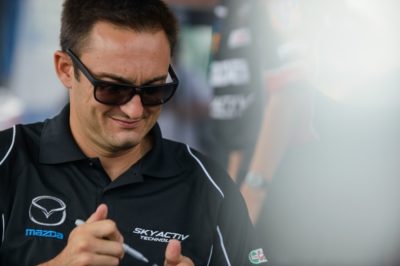As the various national championship events and then the off season approach, many people begin to consider just how they’re going to improve to either secure that title or prepare for next season. For many, the best opportunity to advance their racing ability may be to hire a coach.
Tom Long, in addition to being one of the drivers of the No. 70 Mazda SKYACTIV Diesel Prototype in the TUDOR United SportsCar Championship and an occasional – and winning – driver in a Freedom Autosport MX-5 in the Continental Tires SportsCar Challenge Street Tuner class, is also a coach. Getting the most out of a coaching experience, he says, starts with finding the right person.
“I think it really depends on what you’re trying to accomplish,” he says. “If you’re looking to become a better driver in general, that’s one possibility. If you’re looking to become a better racer and develop your racecraft – if you’re a good driver in general and can put down good lap times but you’re looking to improve your racing … and then, of course, other things like when you feel you’ve kind of plateaued … there are plenty of options.”
Referrals are probably the best way to find a coach, he notes, but there are others. A Web search will likely turn up plenty of local options – and local is more cost effective for most racers. Once you’ve found a coach, Long says that having a clear understanding of what a driver wants will help him or her get the most out of a coached event.
“Have a set of goals in mind,” he explains. “What you want to accomplish, what is the reason for calling a coach in the first place. Talk about them with the coach in advance – maybe a phone conversation before the event would be a very helpful thing. Then, of course, when they’re there, the coach is going to see things maybe you didn’t know existed as potential goals. Maybe this is the way you’ve done it your whole career and it might be a bad habit. Use your goals as a measuring stick for your progress in the event.”
One of the keys to coaching becoming more prevalent and more accessible is the availability of high-tech tools.
“Having a very user-friendly data system that you can install in the car temporarily can give you a lot of good information about what the driver is doing,” says Long of the way he works. “Coupled with in-car video, you can see the steering inputs, driving lines, where the driver is looking – vision being such a critical piece of driving – all these things. You can really learn a lot in a short amount of time.
“Even if they do have a data system in their car, you’d be surprised how someone that’s very skilled in looking at data could actually extract and give feedback based on the data you have. I think someone would be very surprised by how much we can extract and how much information we can give – detailed information such as you can carry more speed in this type of corner, or you can brake later there, or pick up the throttle earlier. Things like that, that you can get out of a data system that’s relatively inexpensive.”
And, especially if you’re a Spec Miata racer, chances are quite good that you can find a coach who has experience in a car very similar to yours. It can be an opportunity to make some big gains in not a lot of time.


 ACCESSIBILITY
ACCESSIBILITY